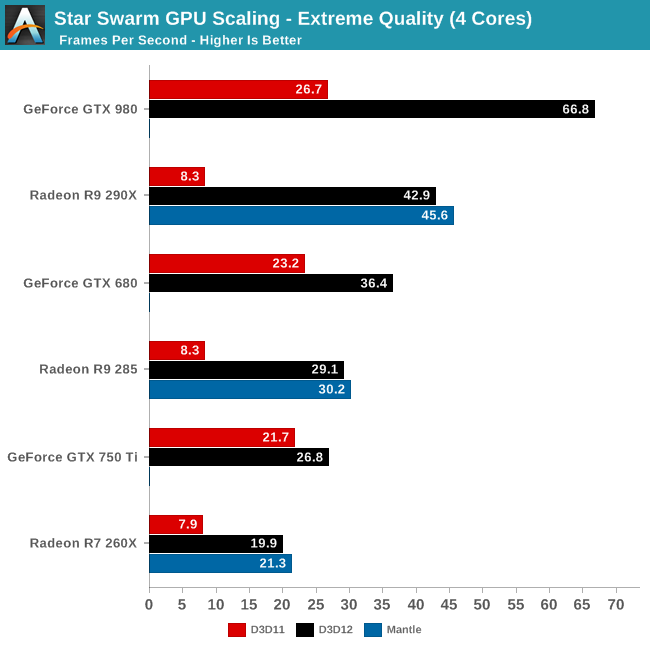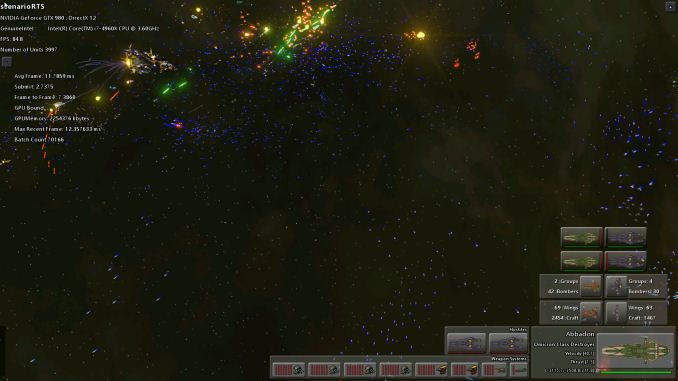The DirectX 12 Performance Preview: AMD, NVIDIA, & Star Swarm
by Ryan Smith on February 6, 2015 2:00 PM EST- Posted in
- GPUs
- AMD
- Microsoft
- NVIDIA
- DirectX 12
Star Swarm & The Test
For today’s DirectX 12 preview, Microsoft and Oxide Games have supplied us with a newer version of Oxide’s Star Swarm demo. Originally released in early 2014 as a demonstration of Oxide’s Nitrous engine and the capabilities of Mantle, Star Swarm is a massive space combat demo that is designed to push the limits of high-level APIs and demonstrate the performance advantages of low-level APIs. Due to its use of thousands of units and other effects that generate a high number of draw calls, Star Swarm can push over 100K draw calls, a massive workload that causes high-level APIs to simply crumple.
Because Star Swarm generates so many draw calls, it is essentially a best-case scenario test for low-level APIs, exploiting the fact that high-level APIs can’t effectively spread out the draw call workload over several CPU threads. As a result the performance gains from DirectX 12 in Star Swarm are going to be much greater than most (if not all) video games, but none the less it’s an effective tool to demonstrate the performance capabilities of DirectX 12 and to showcase how it is capable of better distributing work over multiple CPU threads.
It should be noted that while Star Swarm itself is a synthetic benchmark, the underlying Nitrous engine is relevant and is being used in multiple upcoming games. Stardock is using the Nitrous engine for their forthcoming Star Control game, and Oxide is using the engine for their own game, set to be announced at GDC 2015. So although Star Swarm is still a best case scenario, many of its lessons will be applicable to these future games.
As for the benchmark itself, we should also note that Star Swarm is a non-deterministic simulation. The benchmark is based on having two AI fleets fight each other, and as a result the outcome can differ from run to run. The good news is that although it’s not a deterministic benchmark, the benchmark’s RTS mode is reliable enough to keep the run-to-run variation low enough to produce reasonably consistent results. Among individual runs we’ll still see some fluctuations, while the benchmark will reliably demonstrate larger performance trends.
The Test
For today’s preview Microsoft, NVIDIA, and AMD have provided us with the necessary WDDM 2.0 drivers to enable DirectX 12 under Windows 10. The NVIDIA driver is 349.56 and the AMD driver is 15.200. At this time we do not know when these early WDDM 2.0 drivers will be released to the public, though we would be surprised not to see them released by the time of GDC in early March.
In terms of bugs and other known issues, Microsoft has informed us that there are some known memory and performance regressions in the current WDDM 2.0 path that have since been fixed in interim builds of Windows. In particular the WDDM 2.0 path may see slightly lower performance than the WDDM 1.3 path for older drivers, and there is an issue with memory exhaustion. For this reason Microsoft has suggested that a 3GB card is required to use the Star Swarm DirectX 12 binary, although in our tests we have been able to run it on 2GB cards seemingly without issue. Meanwhile DirectX 11 deferred context support is currently broken in the combination of Star Swarm and NVIDIA's drivers, causing Star Swarm to immediately crash, so these results are with D3D 11 deferred contexts disabled.
For today’s article we are looking at a small range of cards from both AMD and NVIDIA to showcase both performance and compatibility. For NVIDIA we are looking at the GTX 980 (Maxwell 2), GTX 750 Ti (Maxwell 1), and GTX 680 (Kepler). For AMD we are looking at the R9 290X (GCN 1.1), R9 285 (GCN 1.2), and R9 260X (GCN 1.1). As we mentioned earlier support for Fermi and GCN 1.0 cards will be forthcoming in future drivers.
Meanwhile on the CPU front, to showcase the performance scaling of Direct3D we are running the bulk of our tests on our GPU testbed with 3 different settings to roughly emulate high-end Core i7 (6 cores), i5 (4 cores), and i3 (2 cores) processors. Unfortunately we cannot control for our 4960X’s L3 cache size, however that should not be a significant factor in these benchmarks.
| DirectX 12 Preview CPU Configurations (i7-4960X) | |||
| Configuration | Emulating | ||
| 6C/12T @ 4.2GHz | Overclocked Core i7 | ||
| 4C/4T @ 3.8GHz | Core i5-4670K | ||
| 2C/4T @ 3.8GHz | Core i3-4370 | ||
Though not included in this preview, AMD’s recent APUs should slot between the 2 and 4 core options thanks to the design of AMD’s CPU modules.
| CPU: | Intel Core i7-4960X @ 4.2GHz |
| Motherboard: | ASRock Fatal1ty X79 Professional |
| Power Supply: | Corsair AX1200i |
| Hard Disk: | Samsung SSD 840 EVO (750GB) |
| Memory: | G.Skill RipjawZ DDR3-1866 4 x 8GB (9-10-9-26) |
| Case: | NZXT Phantom 630 Windowed Edition |
| Monitor: | Asus PQ321 |
| Video Cards: | AMD Radeon R9 290X AMD Radeon R9 285 AMD Radeon R7 260X NVIDIA GeForce GTX 980 NVIDIA GeForce GTX 750 Ti NVIDIA GeForce GTX 680 |
| Video Drivers: | NVIDIA Release 349.56 Beta AMD Catalyst 15.200 Beta |
| OS: | Windows 10 Technical Preview 2 (Build 9926) |
Finally, while we’re going to take a systematic look at DirectX 12 from both a CPU standpoint and a GPU standpoint, we may as well answer the first question on everyone’s mind: does DirectX 12 work as advertised? The short answer: a resounding yes.












245 Comments
View All Comments
ObscureAngel - Saturday, February 7, 2015 - link
Ryan can you do an article demonstrating the low performance of AMD GPUs in low end CPUs like i3 or anything, in more CPU Bound games comparing to nvidia GPUs in the same CPUs?Unworthy websites have done it, like GameGPU.ru or Digital foundry.
They don't have so much expression because well, sometimes they are a bit dumb.
I confirmed that recently with my own benchmarks, AMD GPUs really have much less performance in the same CPU (low-end CPUs) than an nvidia GPU.
If you look into it and publish maybe that would put a little pressure on AMD and they start to look into it.
But not sure if you can do it, AMD gives your website AMD GPUS and CPUs to benchmark, i'm pretty sure AMD wouldn't like to read the truth..
But since Futuremark new 3dmark is close to release that new benchmark that benchmarks overhead/drawcalls.
It could be nice to give a little highlight of that problem with AMD.
Many people are starting to notice that problem, but AMD are ignoring everyone that claims the lack of performance, so we need somebody strong like Anandtech or other website to analyse these problems and publish to everyone see that something is wrong.
Keep in mind that AMD just fixed the frametime problem in crossfire, cause one website (which i dont remember) publish that, and people start to complain about it, and they start to fix it, and they really fix it.
Now, we already have the complains but we dont have the upper voice like you guys.
okp247 - Sunday, February 8, 2015 - link
Sorry, my bad. The numbers I've stated in the above posts were indeed from either the Follow or Attract scenario.So what is up with the underutilized AMD cards? Clearly, they are not stretching their legs under DX11. In the article you touch upon the CPU batch submission times, and how these are taking a (relatively) long time on the AMD cards. Is this the case also with other draw-call heavy games or is it a fluke in Star Swarm?
ObscureAngel - Monday, February 9, 2015 - link
It happens on games too.I did a video and everything about it.
Spread the word, we need to get AMD attention for this..Since they dont answer me i decided to publicly start to say bad things about them :D
https://www.youtube.com/watch?v=2-nvGOK6ud8
killeak - Saturday, February 7, 2015 - link
Both API (D3D12 and Mantle) are under NDA. In the case of D3D12, in theory if you are working with D3D12 you can't speak about it unless you have explicit authorization from MS. The same with Mantle and AMD.I hope D3D12 goes public by GDC time, I mean the public beta no the final version, after that things will change ;)
Klimax - Saturday, February 7, 2015 - link
Thanks for numbers. They show perfectly how broken and craptastick entire POS is. There are extreme number of idiocies and stupidities in it that it couldn't pass any review by any competent developer.1)Insane number of batches. You want to have at least 100 objects in one to actually see benefit. (Civilization V default settings) To see quite better performance I would say at least 1000 objects to be in one. (Civilization V test with adjusted config) Star Swarm has between 10 to 50 times more batches then Civilization. (Precise number cannot be said as I don't have number of objects to be drawn reported from that "benchmark")
2)Absolutely insane number of superfluous calls. Things like IASetPrimitiveTopology are called (almost) each time an object is to be drawn with same parameters(constants) and with large number of batches those functions add to overhead. That's why you see such large time for DX11 draw - it has to reprocess many things repeatedly. (Some caching and shortcuts can be done as I am sure NVidia implemented them, but there are limits even for otherwise very cheap functions)
3)Simulation itself is so atrociously written that it doesn't really scale at all! This is in space, where number of intersection is very small, so you can process it at maximum possible parallelization.
360s run had 4 cores used for 5,65s with 5+ for 6,1s in total. Bad is weak word...
And I am pretty sure I haven't uncovered all. Note: I used Intel VTune for analysis 1 year ago. Since then no update came so I don't think anything changed at all... (Seeing those numbers I am sure of it)
nulian - Saturday, February 7, 2015 - link
The draw calls are misused on purpose in this demo to show how much better it has become. The advantage for normal games is they can do more light and more effects that use a lot of draw calls without breaking the performance on pc. It is one of the biggest performance different between console and PC draw calls.BehindEnemyLines - Saturday, February 7, 2015 - link
Or maybe they are doing that on purpose to show the bottleneck of DX11 API? Just a thought. If this is a "poorly" written performance demo, then you can only imagine the DX12 improvements after it's "properly" written.Teknobug - Saturday, February 7, 2015 - link
Wasn't there some kind of leaked info that DX12 was basically a copy of Mantle with DX API? Wouldn't surprise me that it'd come close to Mantle's performance.dragonsqrrl - Sunday, February 8, 2015 - link
Right, cause Microsoft only started working on DX12 when Mantle was announced...bloodypulp - Sunday, February 8, 2015 - link
You're missing the point. Mantle/D12 are so similar you could essentially call DX12 the Windows-only version of Mantle. By releasing Mantle, AMD gave developers an opportunity to utilize the new low-level APIs nearly two years before Microsoft was ready to release their own as naturally it was tied to their OS. Those developers who had the foresight to take advantage of Mantle during those two years clearly benefited. They'll launch DX12-ready games before their competitors.